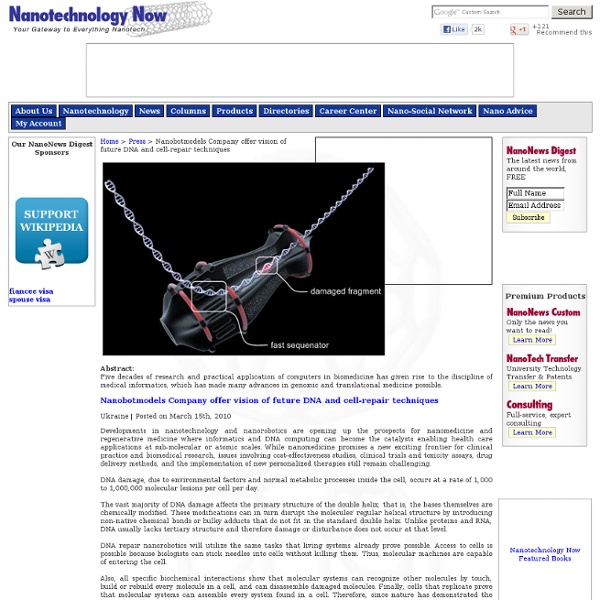Phagocyte
During an infection, chemical signals attract phagocytes to places where the pathogen has invaded the body. These chemicals may come from bacteria or from other phagocytes already present. The phagocytes move by a method called chemotaxis. History[edit] Ilya Ilyich Mechnikov in his laboratory The Russian zoologist Ilya Ilyich Mechnikov (1845–1916) first recognized that specialized cells were involved in defense against microbial infections. A year later, Mechnikov studied a fresh water crustacean called Daphnia, a tiny transparent animal that can be examined directly under a microscope. In 1903, Almroth Wright discovered that phagocytosis was reinforced by specific antibodies that he called opsonins, from the Greek opson, "a dressing or relish".[19] Mechnikov was awarded (jointly with Paul Ehrlich) the 1908 Nobel Prize in Physiology or Medicine for his work on phagocytes and phagocytosis.[7] Phagocytosis[edit] Phagocytosis in three steps: 1. Methods of killing[edit] Extracellular[edit]
Lesch–Nyhan syndrome
Lesch–Nyhan syndrome (LNS), also known as Nyhan's syndrome, Kelley-Seegmiller syndrome and juvenile gout,[1] is a rare inherited disorder caused by a deficiency of the enzyme hypoxanthine-guanine phosphoribosyltransferase (HGPRT), produced by mutations in the HPRT gene located on the X chromosome. LNS affects about one in 380,000 live births.[2] The disorder was first recognized and clinically characterized by medical student Michael Lesch and his mentor, pediatrician William Nyhan, who published their findings in 1964.[3] The HGPRT deficiency causes a build-up of uric acid in all body fluids. This results in both hyperuricemia and hyperuricosuria, associated with severe gout and kidney problems. LNS is an X-linked recessive disease: the gene mutation is usually carried by the mother and passed on to her son, although one-third of all cases arise de novo (from new mutations) and do not have a family history. Signs and symptoms[edit] Overproduction of uric acid[edit] LNS in females[edit]
Nutrición Hospitalaria - Aplicaciones clínicas del empleo de probióticos en pediatría
Aplicaciones clínicas del empleo de probióticos en pediatría Clinical applications of the use of probiotics in pediatrics Guillermo Álvarez-Calatayud, Jimena Pérez-Moreno, Mar Tolín y César Sánchez Sección de Gastroenterología y Nutrición Pediátrica. Dirección para correspondencia Introducción: El empleo de probióticos supone un novedoso avance en el campo de la Pediatría puesto que pueden ser útiles en la prevención y tratamiento de múltiples patologías gastrointestinales, constituyendo un elemento más en nuestro arsenal terapéutico. Palabras clave: Microbiota intestinal. Introduction: The use of probiotics supposes a novel advance in the field of Pediatrics since they can be useful in the prevention and treatment of many gastrointestinal pathologies, constituting one more element in our therapeutic arsenal. Key words: Gut microbiota. Introducción Diarrea aguda adquirida en la comunidad El efecto beneficioso es más significativo en las diarreas producidas por rotavirus. Estreñimiento
Nutr. Hosp. vol.24 número3; Resumen: S0212-16112009000300003
Resumen BENGMARK, S.; MESA, M.ª D. y GIL, A.. Efectos saludables de la cúrcuma y de los curcuminoides. Nutr. Hosp. Las plantas contienen un gran número de sustancias de naturaleza polifenólica con capacidad para reducir los procesos inflamatorios y, por lo tanto, incrementar la resistencia a determinadas enfermedades. Palabras llave : Diabetes; Alzheimer; Cúrcuma; Curcuminoides.
Medicina alternativa y complementaria en la enfermedad inflamatoria intestinal
Revisión Complementary and alternative medicine in the inflammatory bowel disease N. Manceñido Marcos, Sección Aparato Digestivo, Hospital Infanta Sofía, San Sebastián de los Reyes, Madrid, España Received 27 May 2015, Accepted 4 June 2015, Available online 19 August 2015 Choose an option to locate/access this article: Check if you have access through your login credentials or your institution Check access doi:10.1016/j.eii.2015.06.006 Get rights and content Resumen El uso de medicina alternativa y complementaria (MAC) en pacientes con enfermedad inflamatoria (EII) es muy frecuente. Abstract The use of Complementary and Alternative Medicine (CAM) in Inflammatory Bowel Disease (IBD) patients is very common. Palabras clave Medicina alternativa y complementaria; Enfermedad inflamatoria intestinal; Colitis ulcerosa; Enfermedad de Crohn; Fitoterapia; Medicina cuerpo-mente; Acupuntura; Medicina tradicional china Keywords
CURCUMA LONGA Y SU PONTENCIAL MOLECULAR BENEFICIOSO SOBRE LOS PROCESOS INFLAM...
Jurenka J. Anti-inflammatory Properties of Curcumin, a Major Constituent of Curcuma longa: A Review of Preclinical and Clinical Research. AlternMed Rev 2009;14(2):141-153. Colombia Alternative Development (CAD) Project. Manual de Fitoprotección y Análisis de Plaguicidas. Cultivo: plantas medicinales. Jacob A, Wu R, Zhou M, Wang P. Basnet P, Skalko N Curcumin: An Anti-Inflammatory Molecule from a Curry Spice on the Path to Cancer Treatment Molecules 2011, 16, 4567-4598. Wullaert A, Heyninck K, Janssens S, Beyaert R. García P. Blanco L, Martin J, Gómez A y Egido J. Anand P, Sundaram C, Jhurani S, Kunnumakkara AB, Aggarwal BB. Kim JH, Gupta SC, Park B, Yadav VR, Aggarwal BB. Aggarwal B, Sung B . Kunnumakkara AB, Diagaradjane P, Guha S, et al.: Curcumin sensitizes human colorectal cancer xenografts in nude mice to gamma-radiation by targeting nuclear factorkappaBregulated gene products. Scott DW, Loo G: Curcumin-induced GADD153 gene up-regulation in human colon cancer cells .



